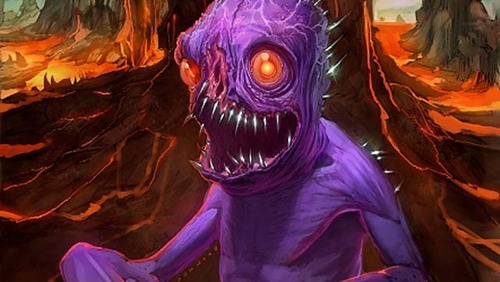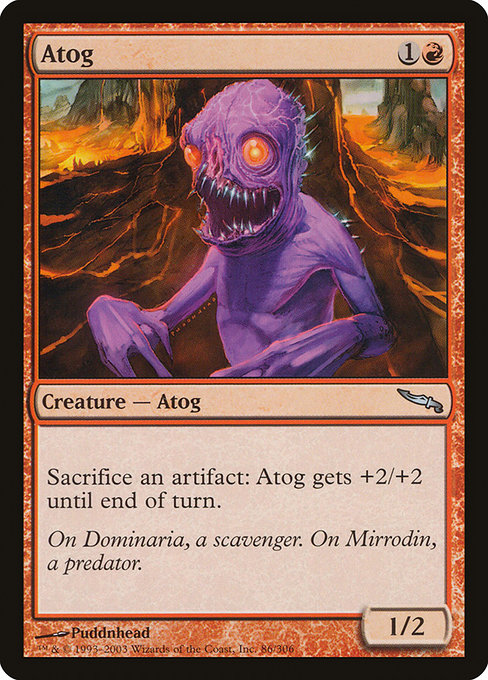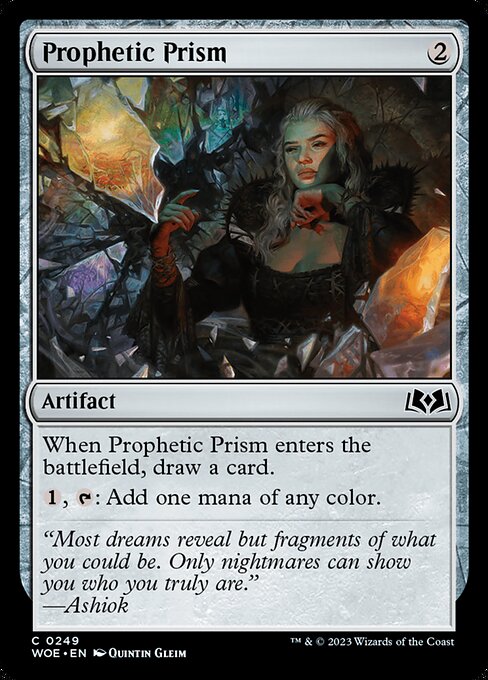We have our first ban announcement for Pauper since the introduction of the Pauper Format Panel! Atog, Bonder's Ornament, and Prophetic Prism are now banned – targeting Affinity and Tron decks.
Below is the official announcement along with the explanation:
Announcement Date: January 20, 2022
Pauper:
Atog is banned.
Bonder’s Ornament is banned.
Prophetic Prism is banned.
Effective Date (Magic Online and tabletop): January 21, 2022, and live on Magic Online around 10 a.m. PT
View the list of all banned and restricted cards by format.
Explanation of bans provided by Gavin Verhey.
Last week, I announced the Pauper Format Panel—or PFP for short. It’s a new group of community members prolific in the Pauper format who will be providing recommendations of format changes to help expedite the level of change.
I’m proud to share that the group has had a lot of great discussions, insights, and analyses since it was formed just a short bit ago. Last week, we reached our recommendation, and after some additional vetting, we now feel confident in enacting it. All seven of us have unanimously agreed on this round of bans.
If you would like to see me break this down in a video, you can check it out here:
Otherwise, let me walk you through our reasoning.
ATOG
The first and clearest thing to us is that something from Affinity needed to go. There are two primary reasons:
- Its popularity and impact were both extremely high. To help quantify this, we took a look at the play numbers on Magic Online, where it’s the most popular deck—over twice as popular as the next most played deck! While it is, surprisingly, not dominant in overall win rate, that is in part because it is metagame warping. Dust to Dust is a card that had become a four-of sideboard option but was also reaching main decks. Cards like Annul, Ancient Grudge, Steel Sabotage, Shenanigans, Gorilla Shaman, Revoke Existence, and so on were all filling up sideboards. Its impact on the format was tremendous and unhealthy.
- The play pattern of the deck can be very non-interactive and frustrating, killing in ways that happen quickly and can’t be blocked. A lot of kills are fueled by Atog and Disciple of the Vault, or Atog with Fling or Wedding Invitation to do a “count to 20” style kill. Sometimes, this is even with countermagic backup like Spell Pierce. When Affinity has a powerful start, usually with an Atog and multiple Disciples, it can set up a kill within the first few turns.
We know that Atog is a beloved card and has been something people have enjoyed since it first appeared in Antiquities. There are a lot of people who like that Pauper is a chance to play with this card. So, we did investigate several other options.
We first talked about Disciple of the Vault, as a lot of the powerful starts are fueled by Atog with multiple Disciples. However, Atog is still the real problem card, giving you a free, repeated sacrifice outlet that can deal the bulk of the damage. Without Disciple, we predict you would just see a movement to more Flings or Wedding Invitations. Disciple was not even a card played in some previous versions of the deck.
We also talked about banning the Modern Horizons 2 Bridges. This would put the deck back to about where it was before Modern Horizons 2. However, that had some challenges.
For one, Bridges are enabling other cool things in the format. We’ve seen the synergy with Cleansing Wildfire, which, for now, seems to be a powerful but fun and fair Pauper interaction. There are fringe decks, like Rakdos Metalcraft, which have been using them to good effect. And with these bans, there may yet be more of an opportunity for them to see play. We could try banning one or two Bridges, but that very surgical approach has no guarantee to solve the issue given the number of colors Affinity plays. Additionally, we think there might be enjoyable versions of Affinity that use the Bridges but not Atog to kill quickly—the quick kills from Atog are a huge part of the issue.
We also investigated Deadly Dispute. This new card from last year gives the deck additional two-card draws while also fixing its colors. However, it is a card which helps you have resiliency and comeback potential in the long game, which is something that points the deck toward a longer game plan that we think is healthy, as opposed to the current version.
We tried to find reasons to not ban Atog, but ultimately, it seemed like the clear and correct choice. We investigated the other options and just kept coming back to Atog.
Our hope is that Affinity moves back to versions that run cards like Carapace Forger to be an aggressive large-creature deck, as opposed to this version that combo kills you with Atog. We know Atog appeared in those decks as well, and there is no easy replacement, but there are still many powerful artifacts-matter cards out there and more that will no doubt appear in the future. Disciple of the Vault with Makeshift Munitions still gives the deck access to reach as well, but in a way that requires mana to use.
Finally, because I am sure some people will be curious, with Atog banned, we also think there is a decent chance we can return Sojourner’s Companion to the deck in a future banned and restricted announcement. However, we don’t want to make that change currently, preferring to wait to see how Affinity turns out after these bans first.
Most of you likely expected an Affinity ban. The other ones might take more explanation, so let me dig in.
BONDER’S ORNAMENT AND PROPHETIC PRISM
With the Atog ban locked in, we looked for what other deck might emerge and be a new problem. We all agreed that we needed to hit something from the Urzatron decks. The reasons are many:
- The data bears out that Tron is extremely powerful. Its win rate in Magic Online Leagues is among the highest (even higher than Affinity, though there was less hate being played against Tron), and when you look at its matchup win percentages after sideboarding, it had a positive win rate against almost every deck.
- Affinity was advantaged against Tron in game one. While Tron did move to an advantaged matchup post-sideboard, it involved bringing in a lot of cards. With Affinity substantially weakened, it opens Tron up to reclaim those sideboard slots and become the dominant deck in the format.
- Pre-Modern Horizons 2, the last time many players would say we had a stable Pauper format, Tron was the most dominant deck.
- Tron pushes out a lot of midrange and control decks, because it’s very hard to compete with the mana and card advantage that the deck creates.
- We banned Expedition Map last year to try and make an impact, but that ban ended up doing very little.
We investigated several possible bans here to moderate the deck but not remove it entirely. While it is possible at some point that we could entirely ban the deck by way of removing the Urzatron lands, we would much rather find ways to reduce its power before going to such an extreme step. I’d like to walk you through what we didn’t hit, and then the reason why we hit the cards we did.
One card we looked at was Moment’s Peace, because the deck uses it to Time Walk the aggressive decks until it can stabilize. (Affinity’s strength against Tron was that it could use Disciple and Fling outside of combat to kill them.) Its synergy with Mystical Teachings is also problematic: a single Teachings represents four skipped combat steps, which is likely to find you the time you need.
However, there are a lot of replacements for Moment’s Peace: Tangle, while weaker, does a lot of what Moment’s Peace does. After that, Respite is a card you could even consider. With Affinity gone, there’s also a higher chance Tron lists could simply play additional copies of Stonehorn Dignitary. Additionally, this only hits Tron on the axis of weakening it against aggressive decks.
Another card we looked at was Mystical Teachings itself. The toolbox engine of the deck is a huge strength, where it can find whatever it needs in the long game. “Tutor with flashback” certainly fits the bill for a bannable card. However, replacing the Teachings engine with more raw card draw, with cards like Compulsive Research or Forbidden Alchemy, the latter of which digs for answers, would make the deck a little less versatile but still powerful in a lot of the same ways. And finally, Mystical Teachings is a card that was previously played in blue-black control decks—a deck that has mostly vanished from the meta because of other pressures but might be able to return to help create a control deck at some point.
We also looked at Crop Rotation, a card that you can Teachings for to make sure you hit your Tron consistently. They usually play two. However, that only slightly hits the deck’s consistency.
Finally, we looked at bans that would impact the loops this deck can create with Mnemonic Wall and Ghostly Flicker or Ephemerate. It’s also possible that some of these “blink” cards may end up being a health issue for the format in the future. However, those pieces have significant redundancy (Ghostly Flicker, Ephemerate, and Displace) and play only a small role in the deck’s plan with one or two copies that are tutorable by Mystical Teachings. They do enable the deck to win and accrue advantage in the long game, but in a way that takes substantial time to set up and ultimately could be converted to several other win conditions.
However, as we were looking into options, above all else, there is one thing that the Tron decks get to do here that is wildly powerful: have access to tons of mana and play all the best cards of all colors. The fact that the deck can play all five colors “for free” is largely on the back of Bonder’s Ornament and Prophetic Prism. Looking at what makes this deck so strong are things like casting Mystical Teachings for whatever the best answer is in any color and having access to anything post-sideboard. It’s a deck that features twelve colorless lands and regularly wants access to all five colors of mana. In fact, in many Tron lists, these are among the only cards played in the full four copies. (Other ones are often Mulldrifter and Impulse.)
Bonder’s Ornament is the more problematic of the two. It was never really intended for competitive Constructed formats as a card that is only at common as a technicality of how we do rarity in Commander decks, and it allows Tron to never run out of gas, keeping pace with both the Monarch decks and any control deck effortlessly. This is a huge problem. Previously, some of those decks could have a shot against Tron, but with the addition of Ornament, you have the long game covered—by a card that already lets you produce mana. Watching the deck play, Boros Monarch goes to great lengths to hold the monarchy and draw an extra card each turn, while Tron just shrugs and keeps drawing with its mana ramp artifact.
We did talk about just banning Ornament, but we did not think it would be enough—the five-color Tron decks thrived before Ornament as well. Prophetic Prism is a card which has long been a staple of decks trying to play as many colors as possible, with Tron chief among them. It fixes your mana at very little cost in a Tron deck and replaces itself. If people reverted to a version that put you down a card, like Prismatic Lens, or was not permanent, like Chromatic Star, that would still be a substantial change.
Additionally, a small part of Prism’s ubiquity has been that it helps make another powerful engine, flicker effects, also not dead. Ghostly Flicker can always cantrip with a Prism on the board, and this slightly reduces the power of Ghostly Flicker both here and in other decks.
While Prism was played in other, fairer decks previously, like Boros Monarch, there are other two mana cantripping artifacts, like Spare Supplies, that have removed the inclusion of Prism for decks that don’t need to fix their mana in an egregious way.
On a larger format scale, we think cards that let you easily play all five colors “for free” (replacing themselves) are probably not healthy for the format. Prism has done that for a while. To be clear: Manalith and Mana Cylix are not an issue; we’re not going down some “ban everything until Manalith is too good” path. This issue concerns having the mana to cast combined with returning your card. The philosophy here is not that different from banning Arcum’s Astrolabe, which has seen bans in multiple formats for both power and enabling access to colors too freely. While this does cost an additional mana, that is not much of an ask in a deck like Tron.
Continuing to look down the five-color issue, Prism is also played in the current Affinity deck (as a noncrucial two- or three-of) and is part of what fuels that five-color deck—which has ultimately turned out to be a problem given how many different colors it helps you play without a cost. The fact that Prism is also in Affinity and gets this as splash damage as an acceptable and likely upside.
With the color fixing banned, we expect to see more Temur-centered Tron decks focused around turboing into big creatures—there’s a version right now played by a player named Horobi on Magic Online called Cascade Tron that has cards like Maelstrom Colossus, Boarding Party, and Annoyed Altisaur and sees powerful gameplay, but is also more answerable than the current five-color control versions. In the past, there was a Temur deck called Fangren Tron, which is similar and was widely accepted as a healthy Tron deck for the format.
Finally, like Sojourner’s Companion in Affinity, it’s possible we could return Expedition Map in a future banned and restricted update but would like to see how the metagame and Tron shake out before returning any cards to that deck.
TIMELINE
We talked a lot about how this would impact the format, and we expect this will cause a lot of movement in the format. It’s tough to be sure of what’s going to happen next.
Decks like Faeries, Monarch, and blink-focused decks were strong before and were not hit by these bans. Those decks may end up fine, and with predators, one of them (or some other deck) might take the top seat at the table. Rather than look ahead too many steps after these substantial changes, we would like to enact these and see how the format shakes out and what decks it opens up. Then, we will monitor the format throughout Kamigawa: Neon Dynasty preview season and release. If there are more changes to be made in the short term, you would most likely see them in March as we look at how the metagame after these bans has settled and whether Kamigawa: Neon Dynasty has impacted the format at all.
If you have any thoughts or questions, you’re welcome to reach out to any of us on the PFP. We hope you enjoy the new Pauper format, and we’re looking forward to watching the challenges (including the ones this weekend!) to see what shows up.
Gavin, on behalf of the Pauper Format Panel:
Alex Ullman – @nerdtothecore
Alexandre Weber – @Webermtg
Emma Partlow – @Emmmzyne
Gavin Verhey – @GavinVerhey
Mirco Ciavatta – @Heisen011
Paige Smith – @TheMaverickGal
Ryuji Saito – @Saito_o3




